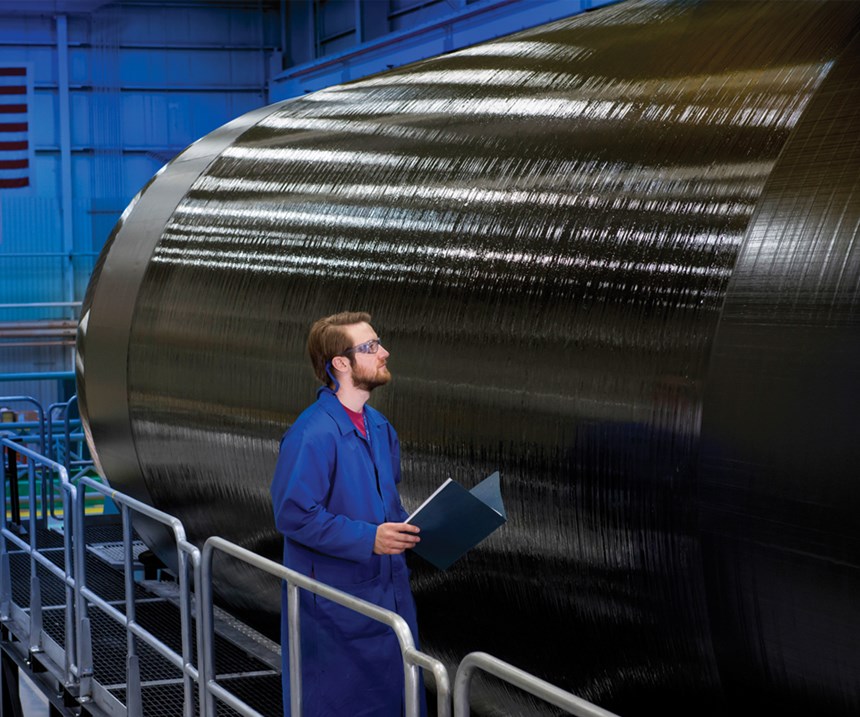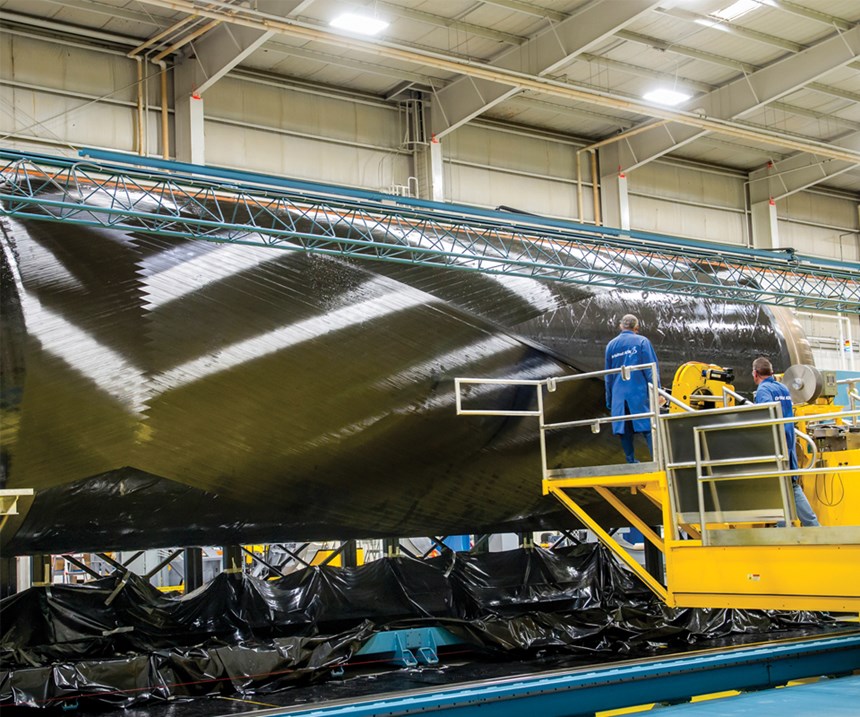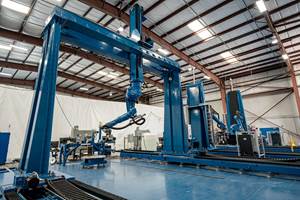Composite cases fuel commercial space venture
Launch vehicle supplier Orbital ATK is looking to break into the burgeoning commercial space market with a rocket motor that features an all-carbon fiber case.
Best known as the supplier of the solid rocket boosters used on NASA’s previous Space Shuttle program, Orbital ATK’s (Dulles, VA, US) primary line of business has always been its solid-fuel booster systems that power a variety of US military nuclear missiles and interceptors. Recently, in an effort to branch out, the company has taken aim at the intermediate- and heavy-class space launch market with the introduction of its Next-Generation Launch (NGL) system. The rocket’s primary components, including the solid-fuel motors and composite case, are currently undergoing testing at ATK’s facility in Magna, UT, US. The project is part of the US Air Force’s Evolved Expendable Launch Vehicle (EELV) program. Its goal is to develop new US-built booster launch systems that will effectively end current reliance on the Russian-built RD-180, which has been the only rocket that could provide the launch capabilities the US requires.
In parallel with Air Force strategic objectives, Orbital ATK is looking to leverage the technological synergies envisioned in the 2014 merger of Alliant Techsystems (ATK), with its experience in solid fuel propulsion, and Orbital Science, with its expertise in launch vehicle systems. The NGL is expected to demonstrate the combined company’s capability to craft total vehicle solutions, thus paving the way to a larger footprint in the commercial space market.
CFRP for solid fuel main stage
The NGL will illustrate that thesis with a hybrid launch system that comprises a segmented solid-fuel main stage and an upper stage powered by a cryogenic engine. The basic segment, referred to as the CASTOR 300, is 3.66m wide by 9.5m long. Its exterior case, of carbon fiber-reinforced polymer (CFRP), is built with a unique joint system, which provides the flexibility to manufacture three different rocket systems, depending on launch and payload requirements: a single segment, the CASTOR 300; a CASTOR 600, comprising two segments 19m in length; and a CASTOR 1200, combining four segments, at a total length of 38.4m.
The company is planning to build two versions of the combined first and second stage launch system: the 500 Series and the 500 XL Series. The former, for use in a geosynchronous transfer orbit (GTO), features a solid-fueled CASTOR 600 (two-segment) first stage and a CASTOR 300 second stage, with the cryogenic upper portion, and a payload capacity of 5,500-8,500 kg. The 500 XL Series comprises a CASTOR 1200 first stage and a CASTOR 300 second stage, with a payload of 5,250-7,000 kg, designed for geostationary equatorial orbit (GEO). The 500 Series will be equipped with a 5m diameter by 15m long payload fairing, while the 500 XL Series will have an identical fairing or one measuring 5m diameter by 20m long.
John Slaughter, the company’s VP of commercial programs, says the NGL has completed critical design reviews of the first and second stages, a procedure that finalizes the basis for design of the solid rocket motors. It has also built the first CASTOR 300 CFRP case at its refurbished 6,132m2 case production facility in Utah. The company uses a proprietary filament winding process it developed in-house to manufacture the case. This fabrication process, Slaughter reports, has become one of the company’s core competencies.
First, PAN-based HexTow IM7 12K carbon fiber (Hexcel, Stamford, CT, US) is wet-wound employing a proprietary CLRF-100 epoxy resin, also developed by Orbital ATK. The fiber, a high-tensile and high-modulus aerospace-grade qualified to the NMS 818 CF Specification (NCAMP), has a density of 1.78 g/cm3 and a filament diameter of 5.2µ. Notably, when winding is complete, but before final cure, the case is removed from the mandrel and a peroxide-cured EPDM (ethylene propylene diene monomer) insulation layer is wound on the case’s inner diameter. Although it’s conventional practice to apply the EPDM first down on the mandrel, then overwind it with the carbon fiber, anomalies can be introduced into the rubber surface during demolding, caused by friction at the rubber/mandrel interface. Orbital ATK’s two-step alternative, made feasible by the large diameter of the case, improves consistency in the rubber layer’s thickness. The rubber is then cured in the case in an autoclave at an unspecified temperature. Total postcured thickness of the case’s carbon fiber wall is about 66 mm near the joints and approximately 25.4 mm in the cylinder region.
Orbital ATK has previously used CFRP in the manufacture of components for its space vehicles, most recently in the S.S. John Glenn Cygnus spacecraft, which completed its supply mission to the International Space Station this spring. The spacecraft’s circular aft deck structure is designed with a CFRP skin; a CFRP/aluminum honeycomb core sandwich panel comprises the rigid substrates of the vehicle’s solar panels. The company also has used CFRP in the cases built in Utah for the Titan GEM and Orion solid-fuel rocket motors. The carbon fiber cases being built for the NGL, however, are unique in several respects. “This is the largest composite case we’ve ever built,” says Slaughter. In turn, the size of the casing’s joined segments, and the loads it will experience in operation, also required a robust joint design.
After it is completed, the casing for the CASTOR 300 segment will be subject to several full-scale tests. In one test, the case is locked in a fixture, filled with water, and the water is pressurized, using a mechanical piston. The case must withstand these high pressures to be cleared for operation — specifically, for the NGL, a test pressure of >1,280 psi. In a separate test, using another fixture, engineers induce dynamic transverse and shear loads on the case like those induced by propulsion in an actual launch. Lastly the solid propellant, a mixture of oxidizer, fuel and binding polymer, is loaded into the case for static testing. The “live” motor is horizontally attached to a test stand abutting a thrust block to prevent movement, and then is fired.
To date, the Air Force and Orbital ATK have invested a combined US$200 million on the NGL project. Orbital is currently producing and installing tooling with plans, upon successful completion of the final phase of testing, to begin full-scale manufacturing in late 2018 or early 2019, with certification test flights planned for 2021.
Launching into heavy orbital traffic
The NGL development work is coming amid a flurry of new commercial space hardware activity as the main players in this arena seek to provide larger payload delivery capability with shorter turnaround times. In June, Space Exploration Technologies Corp. (SpaceX, Hawthorne, CA, US) delivered a 2,722-kg payload to the International Space Station via its Falcon 9 rocket, set a goal of two launches per month this year and is conducting tests on a larger version of Falcon 9, the Falcon Heavy. United Launch Alliance (ULA, Centennial, CO, US) is testing and building the new Vulcan line of launchers to replace its workhorse Atlas V and Delta IV rockets.
Orbital ATK’s initial plans for the NGL entail capturing four or five US national security satellites a year, projecting a cost reduction to the US government of US$600 million over 10 years via manufacturing economies of scale and other process and procurement improvements. If it does, and if work on the NGL, thus far, is an indication, it will, composites will be a key to its success.
Related Content
Innovation in ultrasonic inspection and nondestructive testing
With increasingly complex structural components working their way into aerospace programs, the need for versatility in inspection and testing capabilities is growing.
Read MoreAutomated robotic NDT enhances capabilities for composites
Kineco Kaman Composites India uses a bespoke Fill Accubot ultrasonic testing system to boost inspection efficiency and productivity.
Read MoreASCEND program update: Designing next-gen, high-rate auto and aerospace composites
GKN Aerospace, McLaren Automotive and U.K.-based partners share goals and progress aiming at high-rate, Industry 4.0-enabled, sustainable materials and processes.
Read MoreReinforcing hollow, 3D printed parts with continuous fiber composites
Spanish startup Reinforce3D’s continuous fiber injection process (CFIP) involves injection of fibers and liquid resin into hollow parts made from any material. Potential applications include sporting goods, aerospace and automotive components, and more.
Read MoreRead Next
VIDEO: High-volume processing for fiberglass components
Cannon Ergos, a company specializing in high-ton presses and equipment for composites fabrication and plastics processing, displayed automotive and industrial components at CAMX 2024.
Read MoreDeveloping bonded composite repair for ships, offshore units
Bureau Veritas and industry partners issue guidelines and pave the way for certification via StrengthBond Offshore project.
Read More“Structured air” TPS safeguards composite structures
Powered by an 85% air/15% pure polyimide aerogel, Blueshift’s novel material system protects structures during transient thermal events from -200°C to beyond 2400°C for rockets, battery boxes and more.
Read More























